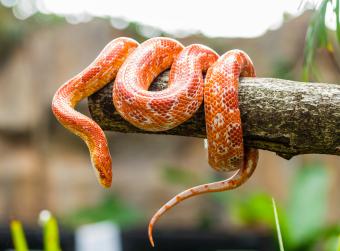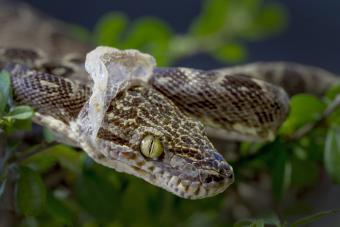
Owning a ball python can be enlightening, entertaining, and rewarding. The most enjoyable aspect, though, is watching them grow as they get older and enjoying their interesting behaviors. A proper diet is essential for the health and happiness of your pet, as well as for their healthy growth, coloring, and longevity.
Natural Diet in the Wild
The ball python (Python regius), often known as the royal python, is a species of snake native to Africa that has become one of the most popular pet snakes due to its small size and simple care requirements. In the wild, these snakes typically consume a range of rodents, such as shrews and mice, and their diet may also include small birds, eggs, frogs, and fish. These are carnivorous snakes that require a meat-based diet in order to survive, both in the wild and when raised as pets in captivity.
Diet in Captivity

A natural and varied diet is the healthiest option to feed a ball python. The more variety and variation you can provide, the healthier your snake will be and the better it will eat. It is imperative that you do not feed your snake a single prey item for an extended period of time, as this may create considerable digestive stress.
The precise diet depends on the snake's age; younger snakes are smaller and cannot swallow or digest material that is too large. Ideally, the snake's prey should be the same size or slightly larger than its widest body segment. Very young snakes should be fed baby mice, whereas older, more mature snakes can eat a wider variety of foods. Although some snakes may consume crickets or other insects, these aren't recommended for snakes in captivity. They don't provide a sufficient amount of nutrients and aren't filling to a mature ball python.
Buying Food
Small mice and other animal types are frequently available for purchase at pet stores, especially specialty pet stores, for reptile nutrition. Interested snake owners may also choose to breed their own mice to ensure a constant supply of food for their pets. Catching wild rodents for the purpose of feeding pet snakes is not recommended, since organisms in the wild may harbor lice, fleas, ticks, or other parasites that can be harmful to the snake as well as the snake's owners.
A Well-balanced Diet
If you're new to keeping snakes, it's important to know that ball pythons are carnivores. This means that they primarily eat other animals, such as mice, rats, birds, and rabbits.
Squeamish snake owners often fantasize about the idea of training their snake to be a vegetarian or conditioning the python to eat only insects or eggs instead of small mammals or rodents. While a few rare snakes may adapt to this type of diet temporarily, it is not nutritious and does not fulfill their nutritional requirements. Snakes that don't eat a proper diet will develop nutritional deficiencies and poor health.
Supplements are also known to be relatively unsuccessful at fulfilling nutritional deficiencies, so if you were thinking you could feed eggs and insects along with supplements, understand this is not an ideal option either. If you are going to bring a python home, be prepared to feed them appropriately.
Feeding Your Python

The organs, skin, and other components of their prey provide vital vitamins, minerals, and nutrients for a healthy pet. It is also crucial to kill the snake's prey before feeding it; even small mice will battle for their lives, and a minor scratch or bite from desperate prey can quickly produce an infection that could prove fatal to the snake. Pre-killed prey can be acquired from pet stores, and frozen mice and rodents can be stored for several weeks if necessary. Before feeding the prey to a python, it must be completely thawed, but not cooked.
Frequency of Feedings
How do you determine if your ball python is eating enough? The answer to this question is straightforward: observe them closely. If you notice that your pet has lost weight and appears thin, increase their food intake. Similarly, if you observe that your pet has gained weight and appears obese, reduce their food intake.
It's crucial to feed your snake an adequate amount of food so that they don't become too thin or too fat while they're growing (or at any other time). Most snakes should be fed every 7 to 10 days. Some snakes are more active than others, necessitating more frequent feeding; some are less active, necessitating less frequent feeding; however, a healthy snake should be fed at most once every 7-10 days.
The exception to this is a baby ball python. They may need to eat twice per week, but again, it's about monitoring your snake: their behavior and their appearance. While feeding schedules can be helpful to monitor how much a snake is eating, slightly randomizing the feedings will more closely simulate how a snake would feed in the wild and can be a healthier diet pattern.
If a young, inexperienced python has difficulty understanding how to eat already dead prey, it is possible to condition the snake to pre-killed prey by wiggling the prey near the snake to simulate movement before it strikes. It will take a few feedings for the snake to become acclimated to consuming prey that has already died. To make the transition easier, warm the prey up in water directly prior to feeding.
It's best not to handle your snake right after feeding since they might regurgitate their meal if you do so immediately afterward. Try waiting at least half an hour before picking them up again. After feeding, it can take four to five days for the snake to digest the prey fully. A warm, dark hiding spot will help smooth digestion. A snake will defecate after digestion is complete.
Signs You're Overfeeding
As mentioned, a ball python can be overfed, resulting in obesity. However, obesity is not the only problem associated with feeding your snake improperly. The following problems may also occur:
- A distended stomach or a "potbelly"
- Inability to shed skin properly
If you notice these signs in your snake, consult with a veterinarian or other expert. We recommend asking someone who has experience caring for snakes about this issue if you're not sure what to do.
If Your Ball Python Doesn't Eat
If your ball python doesn't eat, don't worry. It's normal for them to go through periods of not eating. But if it lasts longer than two days, you should contact a veterinarian or an expert at the nearest pet store or zoo.
As a precaution, check the temperature of the enclosure. Ball pythons need an ambient temperature between 75 degrees and 85 degrees Fahrenheit (24 to 29 degrees celcius) and a basking spot that reaches 100 degrees (37 degrees celcius). If they are too cold or too hot, they won't feel like eating. If it isn't warm enough, place a heating pad underneath one side of the tank so that it stays at least 80 degrees at all times.
Next, make sure that there is adequate humidity in the enclosure. Ball pythons need a humidity level of at least 60 percent. If it's too low, your snake will refuse to eat. Lastly, make sure that your snake has enough water. Reducing their water level will cause them to refuse food, as well.
If you've ensured that your snake's habitat is suitable and they receive adequate natural light, try feeding different foods weekly. If you provide new food items every week, your snake will become accustomed to eating a wider variety of prey and will no longer rely just on one type of food. Variety also offers a method to fill in any nutritional gaps, since each food contains different nutrient levels.
If the snake has not eaten after 45 to 60 days, or if they show other signs of distress, it may be necessary to consult a veterinarian experienced with pet snakes and other reptiles.
Be Prepared
Pythons are not only healthier and happier when they're fed appropriately, but also more likely to thrive, rather than simply survive, in captivity. They are relatively easy to care for and are gradually becoming one of the top pet snake options for beginner snake owners. However, before you bring a ball python home, be certain you are comfortable with their feeding routine and prepared to meet their needs.







